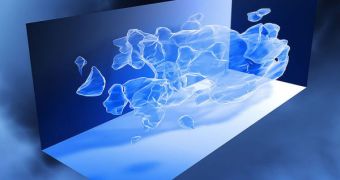A new international astronomical cooperation effort, led by experts at the Cardiff University, in the United Kingdom, has brought to light new evidence that the standard cosmological model in use today, which includes the existence of dark matter and dark energy, is in tune with reality. The proof was collected using a telescope located in Antarctica, near the South Pole, where conditions are optimal for space observations. The experts came to this conclusion after analyzing the remnants of the early Universe, which still permeate all locations in the Cosmos today.
The QUaD telescope project was essentially aimed at studying the Cosmic Microwave Background (CMB), which can very accurately be described as the residual light left behind by the Big Bang. The photons making it up permeate all of the Universe, and exhibit slight differences in temperature, rather than being all at the same level, as one would expect. Astrophysicists believe that this is one of the strongest pieces of evidence there are that dark matter and dark energy make up about 95 percent of the Universe, whereas normal matter only accounts for five percent of everything.
Reporting in a paper published on November 1 in The Astrophysical Journal, the QUaD experts reveal a variety of new maps of the CMB that they created while working out of Antarctica. As a side note, the new Planck telescope, commissioned this May by the European Space Agency (ESA), is also scheduled to observe the CMB and assess temperature variations within it, from its distant L2 Lagrangian orbital point. Studying the background's polarization and temperatures can essentially allow physicists to reconstruct the distribution of matter throughout the early Universe.
“Studying the CMB radiation has given us extremely precise pictures of the Universe at just 400,000 years old. When we first started working on this project the polarization of the CMB hadn't even been detected and we thought we might be able to find something wrong with the theory. The fact that these superb data fit the theory so beautifully is in many ways even more amazing. This reinforces the view that researchers are on the right track and need to learn more about the strange nature of dark energy and dark matter if we are to fully understand the workings of the Universe,” the head of the CU School of Physics and Astronomy, Professor Walter Gear, also the leader of the QUaD team, says.
“When I first started in this field, some people were adamant that they understood the contents of the universe quite well. But that understanding was shattered when evidence for dark energy was discovered. Now that we again feel we have a very good understanding of what makes up the universe, it's extremely important for us to amass strong evidence using many different measurement techniques that this model is correct, so that this doesn't happen again,” the Deputy Director of the Kavli Institute for Particle Astrophysics and Cosmology (KIPAC), Professor Sarah Church, concludes.

 14 DAY TRIAL //
14 DAY TRIAL //